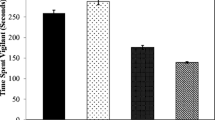Abstract
Various classes of individuals were removed from three captive groups of squirrel monkeys and effects measured on the frequencies of nonagonistic interactions of the remaining individuals. Results indicated that there are regularities in the effects of certain classes of dyadic relationships on others which may be considered species-typical structuring mechanisms ofSaimiri social groups and which account for in consistencies which have appeared between experimentally identified social preferences of adults of this species and their actual behavior in social groups. A tentative process model ofSaimiri social structure and its seasonally changing character is presented and implications of this kind of analytical model for studies of evolution and adaptation are briefly discussed.
Similar content being viewed by others
References
Baldwin, J. D., 1968. The social behavior of adult male squirrel monkeys (Saimiri sciureus) in a seminatural environment.Folia primat., 9: 281–314.
————, 1971. Squirrel monkeys (Saimiri) in natural habitats in Panama, Colombia, Brazil, and Peru.Primates, 12: 45–61.
DuMond, F., 1968. The squirrel monkey in a seminatural environment. In:The Squirrel Monkey,L. Rosenblum &Cooper (eds.), Academic Press, New York, pp. 88–145.
————, 1967. Squirrel monkey reproduction: The “fatted” male phenomenon and seasonal spermatogenesis,Science, 158: 1067–1070.
————, 1967. The fatted male phenomenon and seasonal spermatogenesis.Science, 158: 1067–1070.
Fairbanks, L., 1974. An analysis of subgroup structure and process in captive squirrel monkey (Saimiri sciureus) colony.Folia primat., 21: 209–224.
Kummer, H., W. Gotz, &W. Angst, 1974. Triadic differentiation: An inhibitory porocess protecting pair bonds in baboons.Behaviour, 49: 62–87.
Mason, W., 1971. Field and laboratory studies of social organization inSaimiri andCalicebus. In:Primate Behavior: Developments in Field and Laboratory Research, vol. 2,L. Roseblum (ed.), Academic Press, New York, pp. 107–137.
Strayer, F., M. Taylor, &P. Yanciw, 1975. Group composition effects on social behavior of captive squirrel monkeys (Saimiri siureus).Primates, 16: 253–260.
Thorington, R., 1968. Observations of squirrel monkeys in a Colombian forest. In:The Squirrel Monkey,L. Rosenblum &R. Cooper (eds), Academic Press, New York, pp. 69–87.
Vaitl, E. 1977. Analysis of social context in captive groups of squirrel monkeys (Saimiri sciureus).Primates, 18: 849–859.
----,W. Mason, D. Taub, & C. Anderson, in press. Contrasting effects of living in heterosexual pairs and mixed groups on the structure of social attraction in squirrel monkeys (Saimiri).
Author information
Authors and Affiliations
About this article
Cite this article
Vaitl, E.A. Social context as a structuring mechanism in captive groups of squirrel monkeys (Saimiri sciureus). Primates 18, 861–874 (1977). https://doi.org/10.1007/BF02382936
Received:
Accepted:
Issue Date:
DOI: https://doi.org/10.1007/BF02382936




